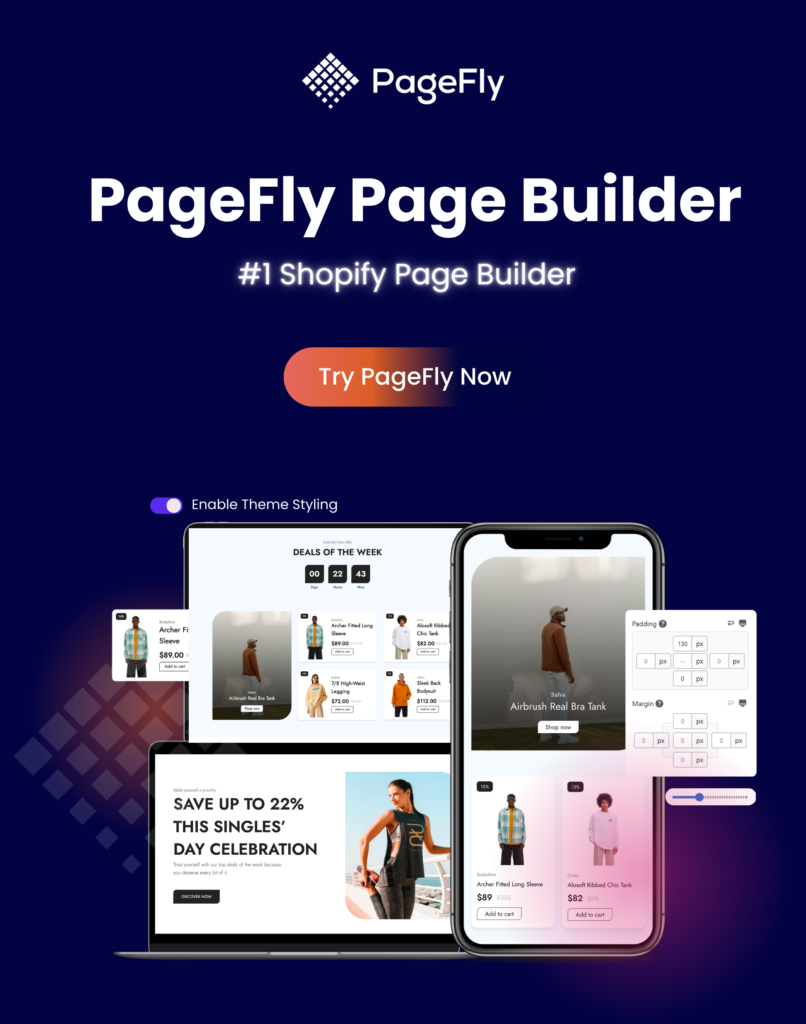Googleで1位になる方法を知りたいですか?適切な Shopify SEO戦略ショップを Google のトップに表示させることは、難しいことではありません。さらに、Google で上位にランクインすると、より多くの潜在顧客があなたのビジネスを見つけられるようになります。そのため、コンバージョン率を次のレベルに引き上げるのに役立ちます。
![[2025ガイド] Shopify SEOチュートリアル:ストアをGoogleで1位にするには?1 [2025 Guide] Shopify SEO Tutorial: How to Rank No 1 on Google with Your Store?](https://storeseo.com/wp-content/uploads/2024/10/1-Shopify-SEO-2025.jpg)
この包括的なチュートリアル ブログでは、Google で上位にランク付けするためのベスト プラクティスを紹介します。ガイドのすべての手順に従うことで、ストアが Google で上位にランク付けされる可能性が高まります。そのため、簡単にショップの発見可能性を高めることができます。さあ、始めましょう!
Google の主要なランキング要因と検索シグナル
手順自体に入る前に、Google検索エンジンプラットフォームの主要なランキング要因について知っておくことが重要です。Googleは 200以上のランキング要因 検索エンジンのランキングに影響を与える。さらに、プラットフォームはいくつかの 主要な検索シグナル ランキング結果は以下のように決定されます。
- 意味: Google の言語モデルは、検索クエリの意味を考慮します。これは、検索者の検索意図を満たすために行われます。Google は、キーワード、言語、ローカリゼーション、現在のイベントを分析してコンテキストを特定します。
- 関連性: Google のシステムはコンテンツを分析して、詳細が検索者の探している内容に関連しているかどうかを確認します。このため、Google は検索クエリとコンテンツで同じキーワードが使用されているかどうかを確認します。また、プラットフォームは集約され匿名化されたインタラクション データやその他の方法を使用して、コンテンツの関連性を見つけます。
- 品質: Google は、検索者にとって最も役立ち、有益なコンテンツを優先的にランク付けします。そのため、コンテンツには専門性、権威性、信頼性が必要です。Google は、常に進化する情報エコシステムも評価します。
- 使いやすさ: Google のシステムは、コンテンツのユーザビリティもチェックします。検索エンジンは、検索者がより有用でアクセスしやすいと感じるコンテンツを優先します。以前のシグナルが比較的同等である場合、これが Google の最も重要な検索シグナルになります。
- コンテクスト: 人間の好奇心と知識を正確に一致させるために、Google 検索ではさまざまな情報と基準を使用してランキング付けを行っています。これらの基準には、場所、過去の検索履歴、検索設定などが含まれます。これは、検索者にとって検索エクスペリエンスが可能な限りパーソナライズされるようにするためです。
StoreSEO: 多機能な AI 搭載 Shopify SEO アプリ
ストアのSEO管理をはるかに簡単かつ迅速にするオールインワンのShopifyアプリをお考えの場合は、 ストアSEO は、選択すべきオプションです。この AI 搭載の Shopify SEO アプリを使用すると、ストアの製品、コレクション、ページ、ブログ投稿を簡単に最適化できます。さらに、高度な AI 機能にアクセスして、コンテンツ、画像、代替テキストを即座に最適化できます。これらすべての多目的な機能により、StoreSEO は Shopify に最適な SEO アプリの 1 つとなっています。
完全な SEO エクスペリエンスを提供するために、StoreSEO は SEO スコア、ローカル SEO、一括最適化、SEO レポート、分析などの追加オプションを提供します。数回クリックするだけで、ショップの SEO パフォーマンスをすばやく改善し、オンラインでの可視性を簡単に高めることができます。このアプリを使用すると、多くの時間を節約でき、手間をかけずにより多くの顧客にビジネスを見つけてもらえるようになります。このブログでは、StoreSEO を使用して Shopify ストアを Google で 1 位にランク付けする方法についても説明します。
Shopify SEOの完全なステップバイステップガイド
Shopify SEO の総合ガイドを詳しく見ていきましょう。製品、コレクション、ページ、ブログ投稿など、Shopify ストアの主要部分すべてを最適化する方法の完全な概要を説明します。これらの手順に従うことで、Shopify ストアの Web サイトで Google のランキングが上がる可能性が高まります。それでは、Google で 1 位になる方法について詳しく見ていきましょう。
注記: インストール StoreSEOアプリ Shopify ストアでこれを使用して、以下にリストされている推奨手順を実際に実装できます。
1. 詳細かつ最適化された製品の説明とブログを書く
まず、ストアの製品の説明とブログがユニークで、顧客にとって十分な情報量であることを確認する必要があります。訪問者は、説明から製品やサービスについて求めているすべての情報を取得できる必要があります。コンテンツは、競合他社のコンテンツよりも目立つほどユニークである必要があります。たとえば、キューバの T シャツの製品の説明には、生地、サイズのバリエーション、色とデザインのオプションなど、求められている詳細が含まれている必要があります。
コンテンツの質が高ければ高いほど、潜在的な顧客がページに留まり、購入する可能性が高くなります。適切なコンテンツの長さは、Google などの検索エンジンによる薄いコンテンツの検出を回避するためにも重要です。
Shopify で商品説明やブログに詳細を追加するにはどうすればいいですか?
商品の説明に詳細を追加するには、Shopifyダッシュボードから商品を編集する必要があります。これを行うには、「製品' タブをクリックします。次に、リストから希望の製品をクリックします。'説明' セクションで、製品の説明をよりわかりやすくするために必要なコンテンツを含めます。
![[2025ガイド] Shopify SEOチュートリアル:ストアをGoogleで1位にするには?2 How to Add Details to Product Descriptions & Blogs on Shopify? 1](https://storeseo.com/wp-content/uploads/2024/10/2-Shopify-SEO-2025.gif)
それでは、ブログ投稿を編集してより説明的なものにする方法を見てみましょう。「販売チャネル' 左側のパネルのボタンをクリックし、'ブログ投稿' オプションを選択します。次に、リストから希望のブログ投稿を選択します。'コンテンツ' セクションで、ブログに必要な情報を追加します。
![[2025ガイド] Shopify SEOチュートリアル: ストアをGoogleで1位にするには? 3 How to Add Details to Product Descriptions & Blogs on Shopify? 2](https://storeseo.com/wp-content/uploads/2024/10/3-Shopify-SEO-2025.gif)
Shopify でブログ投稿を最適化するにはどうすればいいですか?
StoreSEOアプリを使用すると、簡単に SEOのためにShopifyブログ投稿を最適化するStoreSEOアプリを開き、「SEOを最適化する' ボタンをクリックします。次に、'ブログ投稿' タブをクリックします。最適化したいブログに移動します。
![[2025ガイド] Shopify SEOチュートリアル:ストアをGoogleで1位にするには?4 How to Optimize Your Blog Posts on Shopify? 1](https://storeseo.com/wp-content/uploads/2024/10/4-Shopify-SEO-2025.gif)
これで、メタタイトル、メタディスクリプション、タグ、フォーカスキーワード、画像の代替テキストなどを 1 か所で変更できます。StoreSEO は、便利な SEO スコアと基本および詳細な SEO 分析を提供するため、すべてを 1 つずつ最適化できます。
![[2025ガイド] Shopify SEOチュートリアル:ストアをGoogleで1位にするには?5 How to Optimize Your Blog Posts on Shopify? 2](https://storeseo.com/wp-content/uploads/2024/10/5-Shopify-SEO-2025.gif)
2. 商品とコレクションページを最適化する
すべての商品とその説明を追加することは、最初のステップにすぎません。SEOフレンドリーで検索エンジンで見つけやすいものにするためには、 製品はSEOに最適化されています適切なフォーカス キーワード、メタ タイトル、メタ ディスクリプション、URL ハンドル、画像の代替テキストなどを使用する必要があります。コレクション ページについても同様です。また、すべての製品画像が Shopify と SEO の両方に最適化されていることを確認する必要があります。
SEO 向けに Shopify 製品を最適化するにはどうすればよいでしょうか?
に StoreSEOでShopify製品を最適化するアプリを開いて「SEOを最適化する' タブを選択します。'製品' オプションをクリックして、目的の製品に移動します。これで、ブログの投稿やページと同様に、メタタイトル、メタディスクリプション、フォーカスキーワード、URL ハンドルなどのさまざまな領域を最適化できます。また、正確な最適化のために、基本および詳細な SEO 分析を備えた便利な SEO スコア機能も利用できます。
![[2025ガイド] Shopify SEOチュートリアル:ストアをGoogleで1位にするには?6 How to Optimize Your Shopify Products for SEO? 1](https://storeseo.com/wp-content/uploads/2024/10/6-Shopify-SEO-2025.gif)
StoreSEOでは、複数のAIオプティマイザーアドオンも提供しています。AIオプティマイザーアドオンを使用すると、AIクレジットを消費することで、商品、コレクション、ページ、ブログ投稿のSEOコンテンツを即座に生成できます。StoreSEOを使用して商品、コレクション、ページ、ブログを最適化するときは、「生成する' ボタンをクリックします。StoreSEO はフォーカスキーワードに基づいて AI を使って前述の SEO コンテンツを作成します。再生成したり、元に戻したりすることもできます。
![[2025ガイド] Shopify SEOチュートリアル:ストアをGoogleで1位にするには?7 How to Optimize Your Shopify Products for SEO? 2](https://storeseo.com/wp-content/uploads/2024/10/7-Shopify-SEO-2025.png)
Shopify でコレクションを SEO 向けに最適化する方法は?
StoreSEOでコレクションページを最適化する 製品、ページ、ブログ投稿の最適化と同じように機能します。コレクション' タブから 'SEOを最適化する' オプションを選択し、最適化するコレクションに移動します。次に、前に説明したように、コレクション ページを段階的に最適化します。
![[2025ガイド] Shopify SEOチュートリアル:ストアをGoogleで1位にするには?8 How to Optimize Your Collections for SEO on Shopify? 1](https://storeseo.com/wp-content/uploads/2024/10/8-Shopify-SEO-2025.gif)
コレクション ページを最適化する際には、同じ SEO スコアと基本および詳細な SEO 分析がガイドとして提供されます。そのため、Shopify ストアのすべてのコレクションを簡単に最適化できます。
![[2025ガイド] Shopify SEOチュートリアル:ストアをGoogleで1位にするには?9 How to Optimize Your Collections for SEO on Shopify? 2](https://storeseo.com/wp-content/uploads/2024/10/9-Shopify-SEO-2025.gif)
3. Shopifyストアのページを最適化する
ストアのページの最適化も、見逃してはならない重要なステップです。したがって、すべてのページが、十分に調査されたフォーカス キーワードと SEO コンテンツで最適化されていることを確認してください。通常のページを最適化すると、数百または数千の製品ページに対処する場合に比べて、はるかに時間がかかりません。したがって、多くの時間を費やすことを心配せずにこれを行うことができます。
Shopify ストアのページを最適化するにはどうすればいいですか?
StoreSEOは、 Shopifyページの最適化 はるかにシンプル、高速、そして簡単です。製品、コレクション、ブログ投稿と同様に、「SEOを最適化する'オプションを選択して 「ページ」 タブ。そこで、最適化するページを選択します。
![[2025ガイド] Shopify SEOチュートリアル:ストアをGoogleで1位にするには?10 How to Optimize Your Shopify Store’s Pages? 1](https://storeseo.com/wp-content/uploads/2024/10/10-Shopify-SEO-2025.gif)
これで、すべての SEO コンテンツを最適化し、スニペットをプレビューし、その他の作業を簡単に実行できます。アプリが提供する基本および詳細 SEO 分析と SEO スコアに従うだけです。
![[2025ガイド] Shopify SEOチュートリアル:ストアをGoogleで1位にするには?11 How to Optimize Your Shopify Store’s Pages? 2](https://storeseo.com/wp-content/uploads/2024/10/11-Shopify-SEO-2025.gif)
4. 徹底的なキーワードリサーチを優先する
キーワード調査は、SEOパフォーマンスを可能な限り高め、検索エンジンで上位にランク付けするために行うべき主要なことの1つです。キーワードでGoogleで1位にランク付けするには、検索ボリューム、キーワードの難易度、キーワードの長さ、関連キーワードなど、さまざまな指標を分析する必要があります。これらすべての要素を評価し、さまざまな キーワードの種類 Shopify ストアに適したキーワード セットを見つけるのに役立ちます。詳細な説明については、キーワード リサーチに関するブログをお読みください。
キーワード分析に StoreSEO を使用するにはどうすればいいですか?
StoreSEOは、キーワードリサーチの慎重な作業を「キーワード分析' 機能。StoreSEO で商品、コレクション、ページ、ブログ投稿を最適化する場合、このオプションは 'フォーカスキーワード' セクション。
![[2025ガイド] Shopify SEOチュートリアル:ストアをGoogleで1位にするには?12 How to Use StoreSEO for Keyword Analytics? 1](https://storeseo.com/wp-content/uploads/2024/10/12-Shopify-SEO-2025.png)
「キーワード分析' ボタンをクリックすると、StoreSEO は重要なキーワード リサーチ メトリックを多数提供します。選択したフォーカス キーワードの検索ボリューム、クリック単価 (CPC)、有料難易度、関連キーワードに関する情報をリアルタイムで取得できます。この機能を使用して、キーワード リサーチ プロセスを迅速に進めてください。
![[2025ガイド] Shopify SEOチュートリアル:ストアをGoogleで1位にするには?13 How to Use StoreSEO for Keyword Analytics? 2](https://storeseo.com/wp-content/uploads/2024/10/13-Shopify-SEO-2025.png)
5. AIを使用してコンテンツと画像の代替テキストを最適化する
AIは、時間を無駄にすることなくSEOに適したコンテンツを作成するためのeコマースビジネスにとって一般的なツールとなっています。そのため、あなたもそれを活用すべきです。AIをSEOに活用すると、 画像の代替テキストを最適化する、メタタイトル、メタディスクリプション、製品の説明などを驚異的なスピードで作成します。AI を使用する場合は、コンテンツに人間味を加えることを忘れず、コンテンツが顧客にとって有益で役立つものであることを確認してください。
StoreSEO の AI 機能を活用して手間をかけずに最適化するにはどうすればよいでしょうか?
前述のように、StoreSEOはいくつかのAIコンテンツ最適化アドオンを提供しています。これらのアドオンのいずれかを使用すると、AIクレジットを消費して簡単に AIでSEOコンテンツを生成 あなたのストアのために。商品、コレクション、ページ、ブログ投稿を最適化するときは、「生成する' ボタンをクリックします。StoreSEO はメタタイトル、メタディスクリプション、タグのコンテンツを即座に生成します。その後、コンテンツを保持するか、新しいバッチを再生成するかを選択できます。必要に応じて、元のコンテンツに戻すこともできます。
![[2025ガイド] Shopify SEOチュートリアル:ストアをGoogleで1位にするには?14 How to Use StoreSEO’s AI Features for Hassle-Free Optimization?](https://storeseo.com/wp-content/uploads/2024/10/14-Shopify-SEO-2025.png)
StoreSEO を使用して画像の代替テキストを最適化する方法は?
StoreSEOを使用するには AI画像代替テキストジェネレータに移動して、「画像の代替テキストジェネレーターアプリを開いた後、左側のパネルの「」タブをクリックします。画像リストから「生成する' ボタンをクリックします。次のウィンドウで、'AIで生成「'」ボタンをクリックすると、AI で画像の代替テキストを即座に作成できます。必要に応じて代替テキストを再生成したり、元のテキストに戻したりできます。
![[2025ガイド] Shopify SEOチュートリアル:ストアをGoogleで1位にするには?15 How to Use StoreSEO for Optimizing Image Alt Text?](https://storeseo.com/wp-content/uploads/2024/10/15-Shopify-SEO-2025.gif)
6. ローカルSEOで特定の地域での可視性を高める
ビジネスが複数の地理的な場所で運営されている場合は、効果的なローカル SEO 戦略を実装する必要があります。そうすることで、オンライン検索エンジンでのローカル ユーザーへの可視性が向上します。ローカル市場とそのユーザーはそれぞれ異なります。検索パターン、上位のキーワード、顧客の習慣、製品のトレンド、その他の要因は、場所によって大きく異なります。
したがって、ローカルSEOのアプローチを開発する際には、この点に留意する必要があります。製品、製品販売業者、ローカルビジネスにさまざまなスキーマを実装し、最良の結果を検索します。 Google と YouTube アプリ Shopifyアプリストアから Google Merchant Centerに接続する Shopify製品を同期するには Googleビジネスプロフィールを追加する Google マップにもビジネス情報を表示できます。どちらも、使用できる効果的なローカル SEO 手法です。
StoreSEO を使用してローカル検索結果での可視性を向上させる方法は?
StoreSEOアプリは、その多用途な「ローカルSEO' 機能。この便利な機能により、ブレッドクラム、コレクション、製品、製品販売者、ローカルビジネス、記事、ブログ、検索、組織など、複数のスキーマオプションにアクセスできます。この機能を使用するには、アプリを開いて 'ローカルSEO' タブをクリックします。ここで、さまざまなスキーマを有効にし、必要に応じて設定を調整できます。
![[2025ガイド] Shopify SEOチュートリアル:ストアをGoogleで1位にするには?16 How to Improve Visibility in Local Search Results Using StoreSEO?](https://storeseo.com/wp-content/uploads/2024/10/16-Shopify-SEO-2025.png)
7. ショップにソーシャルシグナルを活用する
ソーシャル シグナルの使用は、Shopify ストアのランキングを向上させるもう 1 つの優れた方法です。ソーシャル シグナルとは、さまざまなソーシャル メディア チャネルでのショップのいいね、共有、エンゲージメントを指します。この重要な要素を高めるには、インフルエンサーと提携したり、ソーシャル メディア コンテストを開催して、ソーシャル メディアでの商品のエンゲージメントと可視性を高めることができます。
StoreSEO を使用してソーシャル メディアのプレビュー スニペットを確認する方法は?
StoreSEOを使用してソーシャルメディアのプレビュースニペットを確認できます。製品、コレクション、ページ、ブログ投稿を最適化する際には、「プレビュースニペット' セクション。ここでは、モバイル デバイスとデスクトップ デバイスの両方で、Google 検索、Facebook リンク、X リンクのプレビューが表示されます。
![[2025ガイド] Shopify SEOチュートリアル:ストアをGoogleで1位にするには?17 How to Check Social Media Preview Snippet Using StoreSEO?](https://storeseo.com/wp-content/uploads/2024/10/17-Shopify-SEO-2025.png)
8. SEOレポートと分析でパフォーマンスを追跡する
SEO レポートを定期的に作成することを忘れないでください。すべての商品、コレクション、ページ、ブログ投稿の SEO ステータスを評価します。これにより、注意が必要な最適化されたページを見つけることができます。そのため、何も見逃すことなく、それらのページに対処するための手順を実行し、ショップの SEO パフォーマンスを向上させることができます。Google Analytics やその他の信頼性の高い分析ツールを活用して、さまざまな指標をさらに評価し、SEO 戦略を改良します。分析は、ギャップや新しい戦略を特定して、Google で 1 位にランクする方法を示すのにも役立ちます。
StoreSEO で洞察に富んだ SEO レポートと分析を取得するにはどうすればよいでしょうか?
StoreSEOアプリを使用すると、最適化された製品、最適化されていない製品、コレクション、ページ、ブログ投稿の完全な概要を「レポート' 機能です。この機能を使用するには、StoreSEO を開いて、左側のパネルの対応するタブをクリックします。すると、ストアの SEO プロパティとステータスの完全なレポートが 1 か所に表示されます。
![[2025ガイド] Shopify SEOチュートリアル:ストアをGoogleで1位にするには?18 How to Get Insightful SEO Reports & Analytics with StoreSEO?](https://storeseo.com/wp-content/uploads/2024/10/18-Shopify-SEO-2025.gif)
StoreSEOでは、 Googleアナリティクスと統合するこの統合により、詳細な分析のメリットをすべて享受し、ストアの SEO をさらに強化できます。
9. リンク構築に重点を置く
リンク構築は、ストアが Google で 1 位にランクされるようにするためのもう 1 つの方法です。適切なリンク構築のために、コンテンツに内部リンクと外部リンクの両方を配置することを優先してください。内部リンクは、ユーザーをストアの他のページに誘導するリンクです。一方、外部リンクは、ユーザーを外部の Web サイトに誘導します。関連する製品やコレクションへの内部リンクと、信頼できる権威ある Web サイトへの外部リンクを検討してください。これを行うと、ストアの検索エンジン ランキングにプラスの SEO 影響が残ります。
StoreSEO を使用してストアのリンク ステータスを確認する方法は?
StoreSEOを使用してShopifyページやブログ投稿を最適化する場合、アプリはあなたが使用しているかどうかを教えてくれます。 内部リンク 1 件 そして 外部リンク 1 件 (do-follow 付き) コンテンツにこれらのいずれかを使用していない場合は、StoreSEOは「詳細なSEO分析' セクションを確認してください。これを確認した後、必要に応じて内部リンクまたは外部リンクを追加する手順を実行できます。
![[2025ガイド] Shopify SEOチュートリアル:ストアをGoogleで1位にするには?19 How to Check Link Status on Your Store Using StoreSEO?](https://storeseo.com/wp-content/uploads/2024/10/19-Shopify-SEO-2025.png)
10. ベストプラクティスを維持し、SEO戦略を最新の状態に保つ
Shopify ストアがさまざまな SEO のベスト プラクティスに従っていることを確認することは、長期的に検索エンジンで上位にランク付けされる優れた方法です。そこで、SEO の取り組みを活発かつ実りあるものにするための SEO のベスト プラクティスをいくつか紹介します。
- ユニークで役立つコンテンツに焦点を当てる
- モニター SERPの変動性 そしてそれに応じた行動を取る
- コンテンツが視聴者に的を絞っているか確認する
- 関連性のあるURLを使用し、URLスラッグを最適化します
- クリックに値するメタタイトルとメタディスクリプションを書く
- 一括SEO最適化を活用して時間を節約
- あなたの店が コアウェブバイタル
さらに、SEO 戦略は継続的に更新する必要があります。最新のトレンドや実践を常に把握しておくようにしてください。Google で 1 位にランクインするためのテクニックは数多くありますが、その中にはあなたのストアに非常に効果的なものもあります。また、検索エンジンの新しいアルゴリズムが更新されるたびに、SEO 戦略を調整してください。
Shopify SEO戦略を最適化してランキングを改善し、売上を伸ばす
あなたの e コマース ストアで Google で良いランキングを獲得することは、あなたのビジネスにとって素晴らしいことです。すべてのガイドラインに従い、StoreSEO のような強力な Shopify SEO アプリを使用すると、それはずっと簡単になります。また、Google で 1 位にランク付けするためのベスト プラクティスをより深く理解できるようになりました。
さまざまな方法を試し、最新の SEO トレンドやベストプラクティスを常に把握するようにしてください。検索エンジンのアルゴリズムの更新を常に監視してください。これらすべてを確実に実行すれば、Shopify ストアで Google の 1 位にすぐに上り詰めることができます。
ブログを購読する 最新情報を見逃さないように、皆さんの注目を集める素晴らしい Shopify ビジネスを構築してください。







